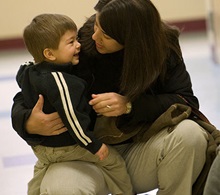 Why do mornings seem so difficult? For parents, especially working parents that use child care in Omaha Nebraska, there is typically so much to do in a short period of time. We here at Premier Academy agree. “Morning is the time in which temperamental differences may be most evident – the child who is slow to get going clashes with the mother or father who is fast paced. Or the child who is crabby clashes with the parent who is also crabby,” say authors Ellen Galinsky and Judy David in their book The Preschool Years: Family Strategies That Work – from Experts and Parents. Mornings also provide the perfect opportunity for children to assert their individuality. With the clock ticking for work and meetings, this is prime time for power struggles.
Why do mornings seem so difficult? For parents, especially working parents that use child care in Omaha Nebraska, there is typically so much to do in a short period of time. We here at Premier Academy agree. “Morning is the time in which temperamental differences may be most evident – the child who is slow to get going clashes with the mother or father who is fast paced. Or the child who is crabby clashes with the parent who is also crabby,” say authors Ellen Galinsky and Judy David in their book The Preschool Years: Family Strategies That Work – from Experts and Parents. Mornings also provide the perfect opportunity for children to assert their individuality. With the clock ticking for work and meetings, this is prime time for power struggles.
Whether your children are going back to school or struggling with a new morning routine, getting ready for school or daycare doesn’t have to be a struggle. The Canadian Child Care Federation offers these tips for discovering how to get ready for school in a way that works for your family.
Tips for a Smooth Morning Routine for School or Daycare
Leave room for unhurried moments. Make sure everybody has enough sleep and rises early enough to avoid rushing. Give yourselves time for some unhurried moments together before you have to leave the house.
Complete chores the night before. To make the morning routine less stressful, do things the night before. After dinner, for example, prepare lunch boxes and leave them in the fridge overnight. And after you clear away the dinner things, set the breakfast table for the next morning. Ask family members to bath/shower/wash hair the night before, if possible. Gather permission forms, lunch money, or notebooks. Encourage your children to help with chores that are suitable for them.
Offer encouragement. If a small child is prone to dawdling, you may have to offer frequent gentle reminders. When you are busy in the kitchen and the child’s room is on another level, have her dress nearby where you can supervise while you work.
Give yourself more time. Add 10 or 15 extra minutes to your usual schedule. If the child is ready on time, spend it reading, talking, or doing some other activity together, making sure you give him your undivided attention during this period.
Set reasonable expectations. Expect your children to do what they are capable of, for example washing and dressing themselves if they are old enough. This may be an unreasonable expectation for a younger child. Set one task at a time to make expectations seem more attainable.
Have a family meeting. When children are old enough to join in a family discussion, sit down together, perhaps the night before, to go over your morning routine and discuss the best morning routine for the entire family.
Get out the door. If a child has not been cooperative, use the extra 10-15 minutes to get him ready with as little fuss as possible. Do not scold or chat; just do what is necessary to leave on time.
Spend time together. Promise and follow through to spend time together after you pick your child up from child care if the morning routine goes smoothly. Don’t forget to recognize your children’s good effort using encouragement on days when everything works well and your family starts the day on time!
Dealing with Resistance to a Daycare or School Morning Routine
Children may resist morning routines by arguing about breakfast food, debating about what clothes to wear, or playing when they should be getting ready to leave. Children often seek our attention in the morning, especially when we are rushing.
Our children soon learn that when they resist, argue, or stall, they get our attention. These morning difficulties may arise even when we give our children plenty of attention at other times. What can you do to spur on the uncooperative child and give him a sense of power and control?
Encourage and remind, but try not to nag. Let them experience the consequences of procrastinating. This may mean missing breakfast or forgetting their homework.
Establish an agreement that the TV doesn’t go on in the morning until the chores are done, if at all.
Create a morning routine chart with your child, and involve your child by asking, “What’s next on the routine chart?” They can help cut out pictures and design the chart. Have stickers for your child to place on the steps she completes.
Use an alarm clock in children’s rooms. This will ensure that you wake them up at the same time each morning and you haven’t gotten lost looking over your emails. This will help prepare toddlers for elementary school as well.
Ask children whether they would like your help getting ready for school.
Avoid lectures. Instead, asking “what” and “how” questions – such as “what happens when you don’t get dressed in the morning?” and “How do you feel about missing the school bus?” – will entice conversation with our children. These questions help children think for themselves, whereas our lectures may make them stop listening.
Talk about times when you have procrastinated, what happened as a result, and how you felt about it. These conversations can be used as teachable moments for your kids.
Plan ahead, and give your child enough time to succeed on his own. Remember to give reminders and establish clear expectations regarding his morning routine.
Let your child know that you need her help and say, “I would appreciate you getting dressed so we can get to school before circle time.” This invites cooperation instead of defiance.
Many of us charge off with our to-do lists in hand, thinking that when everything is done (which it never is) we can enjoy life. But what we do every day is life. Our ability to step in time with our children amid the everyday stuff, such as getting out of the house in the morning, takes some organization and a lot of patience. Using these tips for establishing a morning routine can help you get it done.

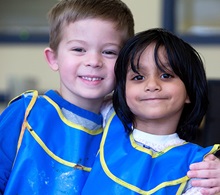 We here at Premiere Academy are big believers in fostering social and emotional development in preschoolers. Social-emotional development affects every aspect of a child’s life, including personal relationships, academic growth, and self-esteem. When children feel good about themselves and have the skills to interact successfully with others, their capacity to achieve skyrockets.
We here at Premiere Academy are big believers in fostering social and emotional development in preschoolers. Social-emotional development affects every aspect of a child’s life, including personal relationships, academic growth, and self-esteem. When children feel good about themselves and have the skills to interact successfully with others, their capacity to achieve skyrockets.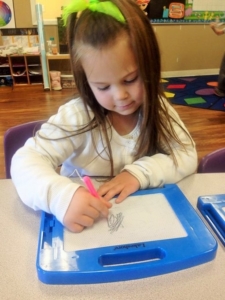 We here at Premier Academy are big believers in play based learning. We understand that one of the wonderful things about being a parent is that you are your child’s first teacher. You have the unique opportunity to open the door to the world; introducing your child to words, colors, animals and so much more. Learning can be weaved into the day naturally as you read, talk, sing, and play together.
We here at Premier Academy are big believers in play based learning. We understand that one of the wonderful things about being a parent is that you are your child’s first teacher. You have the unique opportunity to open the door to the world; introducing your child to words, colors, animals and so much more. Learning can be weaved into the day naturally as you read, talk, sing, and play together. 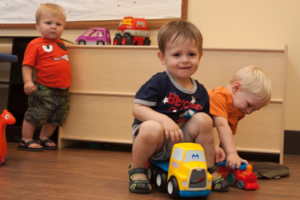 Play along. When your child is playing dress up, caring for her baby doll, pushing a train, or pretending to grocery shop or baking some cookies, play along.
Play along. When your child is playing dress up, caring for her baby doll, pushing a train, or pretending to grocery shop or baking some cookies, play along. 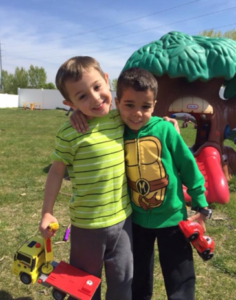 Discover the outdoors.
Discover the outdoors.